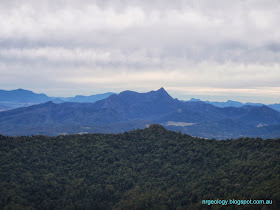 |
| Mount Warning Central Complex from the southern rim of eroded shield |
The accuracy of using the K-Ar dating method is very good, but has some provisos. The most important being that the rock sample must be very 'fresh'. There must be no weathering, alteration or metamorphism of the sample. Because potassium is more reactive than argon and it can be removed or added respectively during weathering and alteration. Additionally, the K-Ar dating 'clock' can be reset during any recrystallisation during metamorphism.
K-Ar dating by Wellman and McDougall (1974) and earlier authors showed that the intrusive complex at Mount Warning was emplaced between ~23.7Ma and 23.0Ma and the surrounding lavas erupted from ~22.3Ma to ~20.5Ma. This doesn't make a lot of sense because an intrusion of magma needs to intrude into something else (otherwise it is not an intrusion!). In the case of shield volcanoes this intrudes the earlier lava that was erupted before. The K-Ar dating shows this is apparently not the case.
What is going on? No one could suggest any reasonable ideas. Cotter (1998) suggested a possibility there may have been a large volume of pre-existing Palaeozoic and/or Mesozoic sedimentary rocks that have now been eroded away. However, Cotter (1998) did date a sample of basalt lava from the Terania Creek area at ~23.9Ma (using K-Ar). This suggested maybe the dating by Wellman and McDougall (1974) and earlier authors might have either missed later lavas or maybe there was something else wrong.
Cohen (2007) spent a lot of time resampling the K-Ar dated volcanic rocks of eastern Australia. This time instead of using K-Ar he used another technique called 40Ar-39Ar dating. This is similar to K-Ar dating in concept. It instead measures the abundance of two isotopes of argon and is much less affected by any effects of weathering and alteration (though not metamorphism). What did he find? He found some of the K-Ar dates were wrong.
Cohen (2007) found the actual date of the lavas was within the range ~24.3 to ~23.6 million years, about 2 million years older than first thought. Though the 40Ar-39Ar date of the Mount Warning Central Complex was quite close at ~23.1Ma it fell within the range of the K-Ar dating (23.7-23.0Ma). This reverses the idea the intrusion of the Mount Warning Central Complex was before the lavas. So, now we know that the final intrusions of the Mount Warning Central Complex does indeed fit the model for shield volcanoes. That is, the intrusions were likely to have been emplaced into already erupted volcanic rock. They were also erupted and emplaced over a period much quicker than first thought. The new dating shows volcanism possibly lasting 1 million years instead of the 3 million previously suggested.
References/bibliography
*Cohen, B.E. 2007. High-resolution 40Ar/39Ar Geochronology of Intraplate Volcanism in Eastern Australia. PhD Thesis, University of Queensland.
*Cotter, S. 1998. A Geochemical, Palaeomagnetic and Geomorphological Investigation of the Tertiary Volcanic Sequence of North Eastern New South Wales. Masters Thesis, Southern Cross University.
*Graham, B.W. 1990. A Natural History - Tweed Gold Coast Region. Tweed River High School Library.
*Wellman, P. & McDougall, I. 1974. Potassium-argon Dates on the Cainozoic Volcanic Rocks of New South Wales. Journal of the Geological Society of Australia v21.
How is it possible that basalt at Fingal allegedly from the Tweed Shield Volcano still retains its hexagonal shape after being exposed to the Pacific Ocean allegedly for hundreds of thousand if not millions of years, while much of the basalt once inland once allegedly thousands of metres thick allegedly from the same erruption has been eroded away almost to oblivion?
ReplyDelete